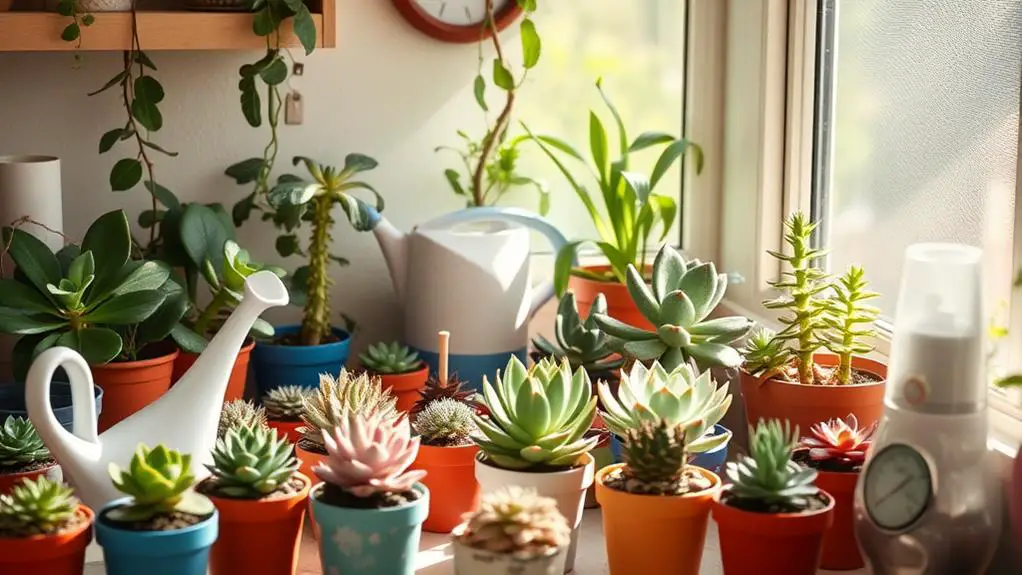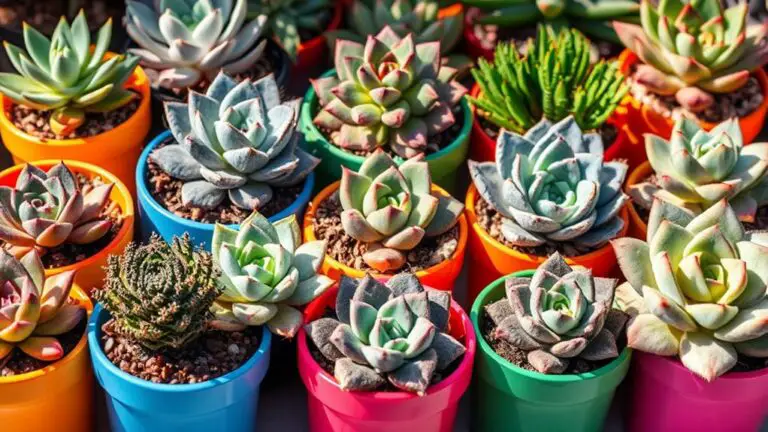7 Essential Tips for Caring for Succulents in Winter
When winter arrives, caring for succulents becomes a bit more complex, and you'll need to adjust your routine to keep them thriving. You might wonder how often to water or where to position them for peak light. Maybe you're curious about the right temperature range or how to shield them from frost. Understanding these nuances can make a significant difference in your succulent's health. Let's explore seven essential tips to guarantee your plants not only survive but flourish during the colder months. Ready to give your succulents the care they deserve?
Adjust Watering Frequency
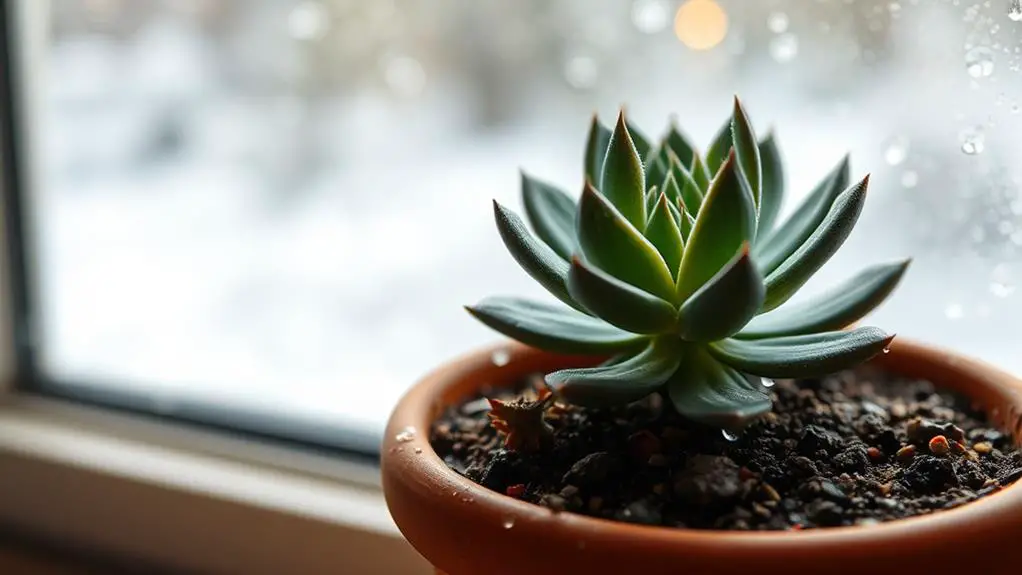
As winter sets in, it's important to adjust the watering frequency for your succulents to guarantee they stay healthy.
During winter dormancy, many succulents require considerably less water. Aim to water them every 4-6 weeks, allowing the soil to dry out completely between waterings. This helps prevent root rot, which is a common problem caused by overwatering.
Indoor succulents may need even less water due to lower evaporation rates. If your plants are near heating vents, the soil might dry out faster, but it's still important to check the soil before watering. Always verify the soil is completely dry before adding water. Underwatering is better than overwatering in winter.
Some succulents mightn't be dormant and could need slightly more frequent watering. Monitor each plant's needs closely.
Using well-draining soil and pots with drainage holes is critical. This setup prevents water from accumulating, protecting your succulents' roots.
Provide Adequate Light
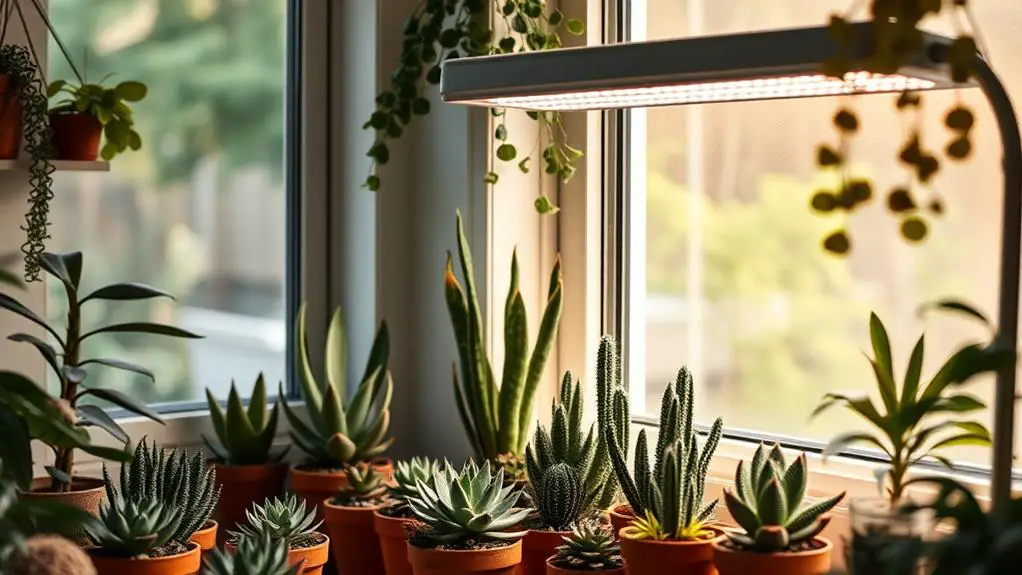
To keep your succulents healthy during winter, make certain they get enough light.
Place them near south or west-facing windows for the best natural sunlight, and consider supplementing with grow lights if needed.
Don't forget to rotate your plants occasionally to guarantee even light exposure and prevent stretching.
Optimal Window Placement
Ensuring your succulents get enough light in the winter is vital for their health and growth. During the colder months, place your succulents near south or west-facing windows for ideal window placement. These locations offer bright indirect sunlight, which is important for their well-being. Aim for at least 6-8 hours of light daily.
Watch for signs of insufficient light. If your succulents start to grow leggy or lean towards the window, it's a clear signal they're not getting enough light. To counter this, rotate pots every few weeks. This helps your plants receive even light exposure and prevents them from stretching.
Here's a quick guide:
| Action | Reason | Frequency |
|---|---|---|
| Place near south/west windows | Bright indirect sunlight | Daily |
| Rotate pots | Even light exposure | Every few weeks |
| Monitor for leggy growth | Signs of insufficient light | Regularly |
Avoid placing succulents near cold windows or drafty spots. Sudden temperature changes can shock them, disrupting their stable light and temperature needs. If natural light isn't enough, you might need grow lights, but remember, they should mimic natural cycles. Follow these tips, and your succulents will thrive all winter long!
Supplement With Grow Lights
Winter's shorter days can make it tough for succulents to get the 6-8 hours of light they need, making grow lights an important supplement. Succulents need bright indirect sunlight, and during winter, providing this can be a challenge.
Full-spectrum LED lights can help you mimic natural sunlight and provide the necessary wavelengths for photosynthesis.
To guarantee peak growth, position your grow lights 12-24 inches above your succulents. Adjust the height based on the light intensity and how your plants respond. Be careful to avoid burning the leaves.
Setting a timer for your grow lights to maintain a consistent light cycle is vital. Aim for about 12-14 hours of light followed by a dark period to mimic natural conditions.
Here are some key tips to keep in mind:
- Choose full-spectrum LED lights: They mimic natural sunlight best.
- Maintain a consistent light cycle: Use a timer to guarantee regularity.
- Monitor your succulents: Look for signs like leggy growth or leaning.
Rotate for Even Exposure
Rotating your succulents every few weeks is essential for ensuring they receive even light exposure. When you keep succulents indoors, it's important to rotate them to prevent uneven growth and leggy stems. Succulents need at least 6-8 hours of bright indirect sunlight each day, especially during winter. If you notice your plants leaning toward the light, it's a sign they need more balanced exposure.
Place your succulents in a bright south or west-facing window to maximize sunlight. Even in these spots, rotation is vital to avoid sunburn on one side. By rotating for even exposure, you help your plants grow straight and healthy. If natural light isn't enough, supplement with a grow light. Remember to rotate your succulents under grow lights too.
Using well-draining soil is also key in winter. It prevents root rot, which can be a bigger issue when light levels are lower.
Be cautious of freezing temperatures, as succulents aren't typically hardy in cold weather. Regularly rotating and providing bright indirect sunlight are simple yet effective ways to care for your succulents and keep them thriving all winter long.
Monitor Temperature
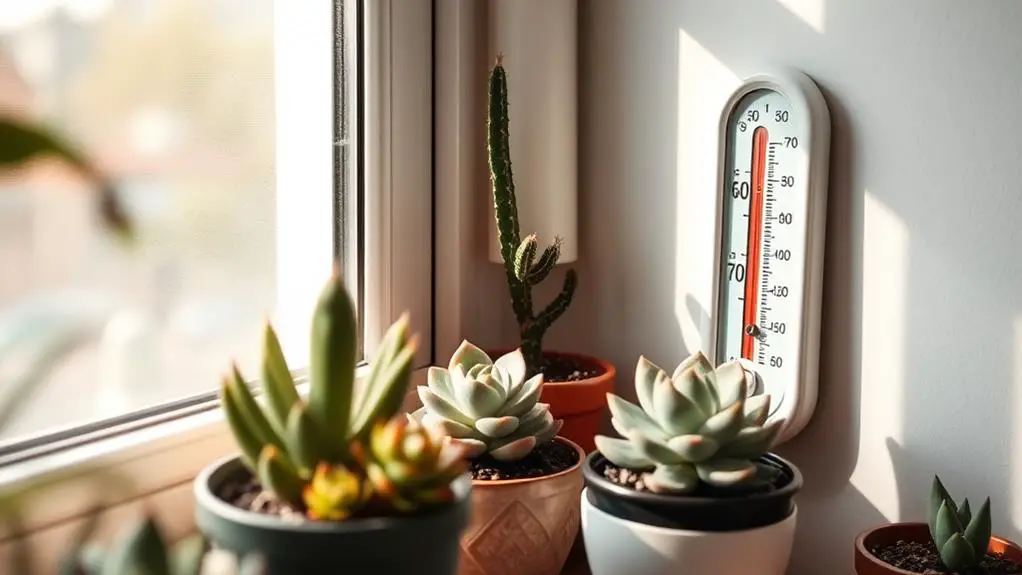
To keep your succulents healthy in winter, make sure indoor temperatures stay between 50°F and 70°F.
Avoid putting them near cold drafts or uninsulated windows to prevent sudden temperature changes that can shock the plants.
Use a thermometer to check that temperatures don't drop below 45°F, ensuring your succulents stay safe and happy.
Ideal Temperature Range
Maintaining the right indoor temperature is essential for the health of your succulents during winter. Keeping succulents inside and within their ideal temperature range of 50°F to 70°F (10°C to 21°C) helps prevent frost damage and guarantees they thrive.
Tender succulents, in particular, need special attention as they're more sensitive to cold. You should monitor indoor temperatures closely to keep your plants happy and healthy.
To care for succulents in winter, it's important to use a thermometer to keep an eye on the temperature. Make certain it doesn't drop below 45°F (7°C), as this could cause stress or even freezing damage.
Here are some key points to take into account:
- Monitor temperatures regularly: Use a thermometer to guarantee your home stays within the preferred range.
- Keep away from drafts: Avoid placing succulents near windows or doors where cold air can seep in.
- Avoid heating vents: Hot air from vents can create sudden temperature fluctuations, which are harmful.
Avoid Sudden Changes**
Fluctuations in temperature can be detrimental to your succulents, causing them unnecessary stress. It's really important to avoid sudden changes in their environment. Aim to keep the indoor temperature between 50-70°F during winter. Sudden temperature changes can shock your succulents, so maintaining a stable indoor environment is key.
Start by monitoring the temperature in your home using a thermometer. This will help you protect succulents from unexpected cold drafts or heat from radiators. Avoid placing your plants near drafty windows or heating sources, as these can cause harmful fluctuations.
If your succulents have been outside, bring them in slowly to acclimate them to the indoor environment. This gradual process will help them adjust without experiencing shock.
Also, keep them away from uninsulated areas where freezing temperatures might occur. Exposure to extreme cold can damage their delicate tissues and even cause frostbite.
Ensure Proper Drainage

When caring for succulents in winter, ensuring proper drainage is essential to their health. Succulents are especially prone to root rot and other issues when water accumulates around their roots. To prevent this, make sure every pot has drainage holes. This allows excess water to escape, promoting healthy growth even in the colder months.
Using well-draining soil is another significant step. This type of soil typically includes materials like sand, perlite, or pumice, which help water pass through quickly. You might also consider adding a layer of gravel or pebbles at the bottom of the pot. This extra layer can further improve drainage and keep water from sitting around the roots.
Don't forget to monitor the moisture level of your soil. It should dry out completely between waterings because overwatering is a common issue in winter when evaporation is reduced.
- Use well-draining soil with sand, perlite, or pumice.
- Ensure pots have drainage holes for excess water.
- Add gravel or pebbles to the bottom of your pots.
Inspect for Pests
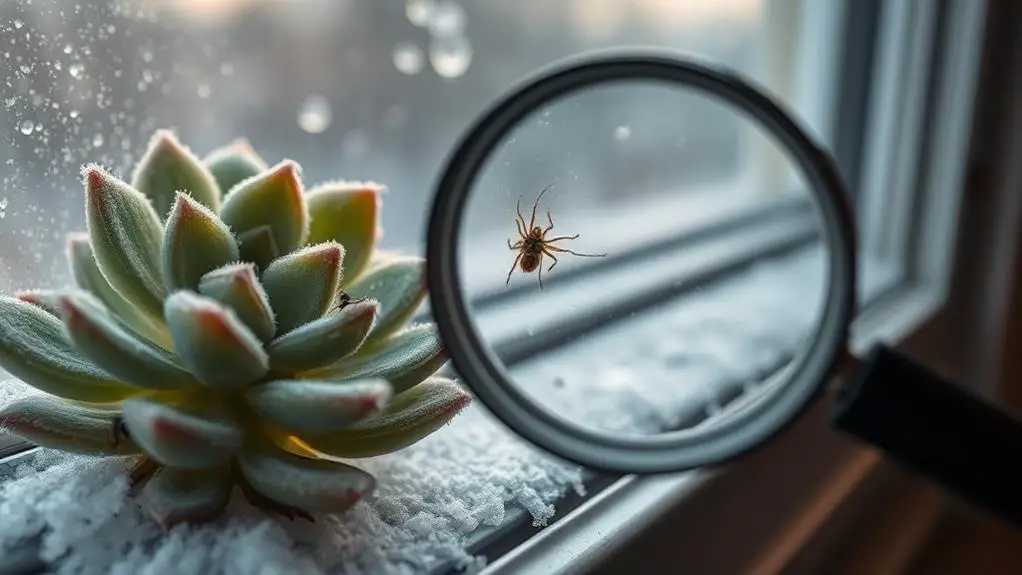
Vigilance is key when it comes to inspecting your succulents for pests during the winter months. Regularly inspect your plants for common pests like mealybugs and aphids. These tiny invaders can cause significant damage if left untreated.
Pay special attention to the undersides of leaves and the base of the plant, as pests often hide in these spots. A magnifying glass can be helpful for closely examining your succulents for any tiny insects or webbing.
If you do find pests, don't panic. Treat the affected plants with insecticidal soap or a mixture of rubbing alcohol and water. This will help eliminate the infestation effectively.
Remember to be thorough in your treatment to guarantee all pests are gone.
It's also a good idea to quarantine any new succulents for at least a week before introducing them to your existing collection. This precaution helps prevent the spread of pests to your healthy plants.
Protect From Frost
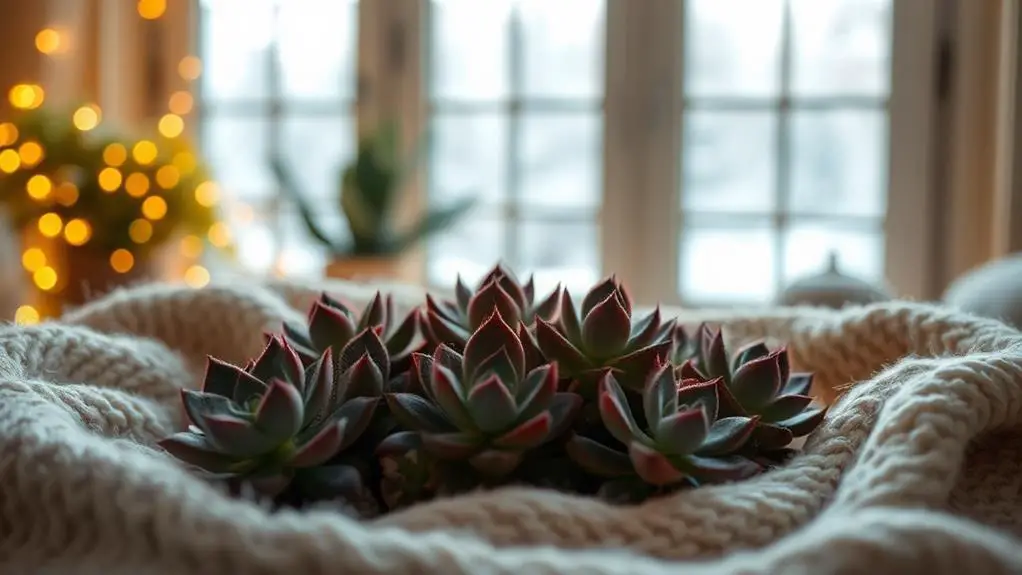
Winter's chill can be a silent adversary to your succulents, especially when frost sets in. To protect your non-hardy succulents from freezing temperatures, bring them indoors before the first frost, typically by the end of September.
Hardy succulents, on the other hand, can stay outside, but you should still monitor outdoor temperatures to prevent frost exposure. If you live in zones 8 or 9, consider using a frost cloth for short-term protection. However, if temperatures drop below 45°F (7°C), it's best to move tender succulents to a sheltered area.
Here are some essential steps to follow:
- Bring non-hardy succulents indoors before temperatures drop.
- Use frost cloth to cover outdoor succulents during unexpected cold snaps.
- Regularly check plant labels to know each succulent's temperature limits.
Monitoring outdoor temperatures is vital. Prolonged exposure to freezing conditions can cause severe damage like dark, mushy tissue or burst plant cells.
Moving your tender succulents inside before they face frost can save them from harm. By taking these precautions, you can guarantee your succulents thrive even in the coldest months.
Recognize Stress Signs
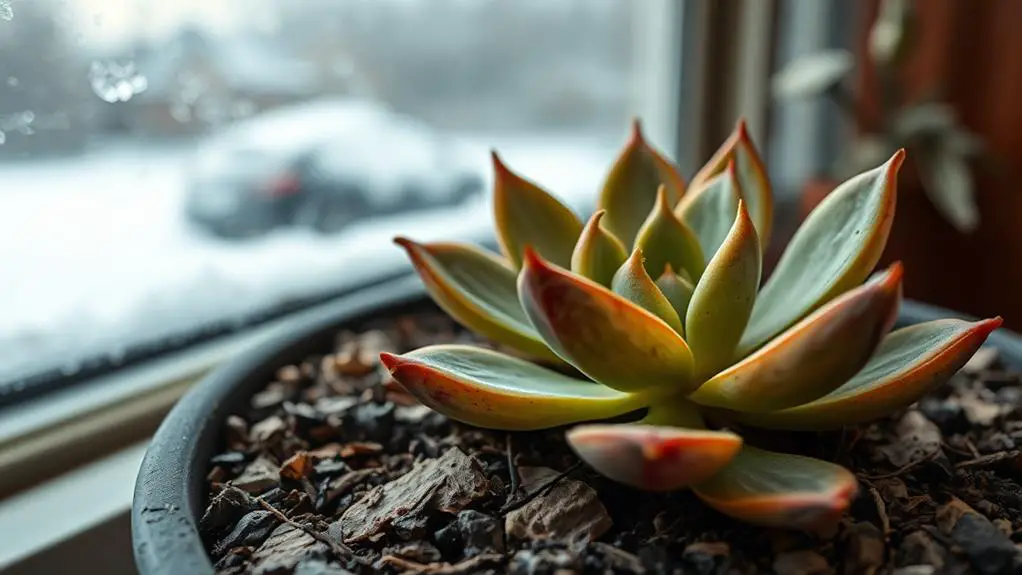
Identifying stress signs in your succulents can be the difference between a thriving plant and one on the brink of decline.
Yellowing leaves often point to overwatering or poor drainage. On the other hand, wrinkled leaves might mean your plant is underwatered or suffering from low humidity levels. Keep an eye on your watering habits and the moisture of the soil.
Stunted growth is another red flag. This usually happens due to light deficiency. During winter months, natural light may be scarce, so consider using grow lights to give your succulents the light they need.
If you notice mold or fungus on the soil surface, it's likely a sign of overwatering or poor air circulation. Left unchecked, this can lead to root rot. To prevent this, guarantee good drainage and avoid letting water sit in the saucer.
Dropping leaves can indicate environmental stress or shock, often caused by sudden temperature changes or improper watering practices.
Frequently Asked Questions
How Do I Keep My Succulents Alive in the Winter?
To keep your succulents alive in winter, bring them indoors before frost, water sparingly, and place them near south or west-facing windows. Maintain temperatures between 50°F and 70°F, and inspect regularly for pests and dead leaves.
What Should I Cover My Succulents With in the Winter?
Cover your succulents with horticultural fleece or breathable frost cloths to protect them from frost damage. Make certain the covers allow air circulation and light. For potted succulents, move them to a sheltered area and cover.
How Often Should You Water Succulents in the Winter?
You should water succulents every 4 to 6 weeks in winter. Let the soil dry out completely between waterings. Check soil moisture with your fingers, and only water when the top inch feels dry to avoid overwatering.
How Do I Give My Succulents More Light in the Winter?
Place your succulents near south or west-facing windows for maximum sunlight. If natural light is insufficient, use grow lights 6-12 inches above them for 12-16 hours daily. Rotate pots regularly to guarantee even light distribution.
Conclusion
You've got all the tips you need to keep your succulents happy and healthy this winter. Remember to water them sparingly, give them plenty of light, and keep an eye on the temperature. Make sure they have good drainage, watch for pests, and protect them from frost. Pay attention to any signs of stress, and address them quickly. With these steps, you'll be a succulent care pro in no time. Happy gardening!

